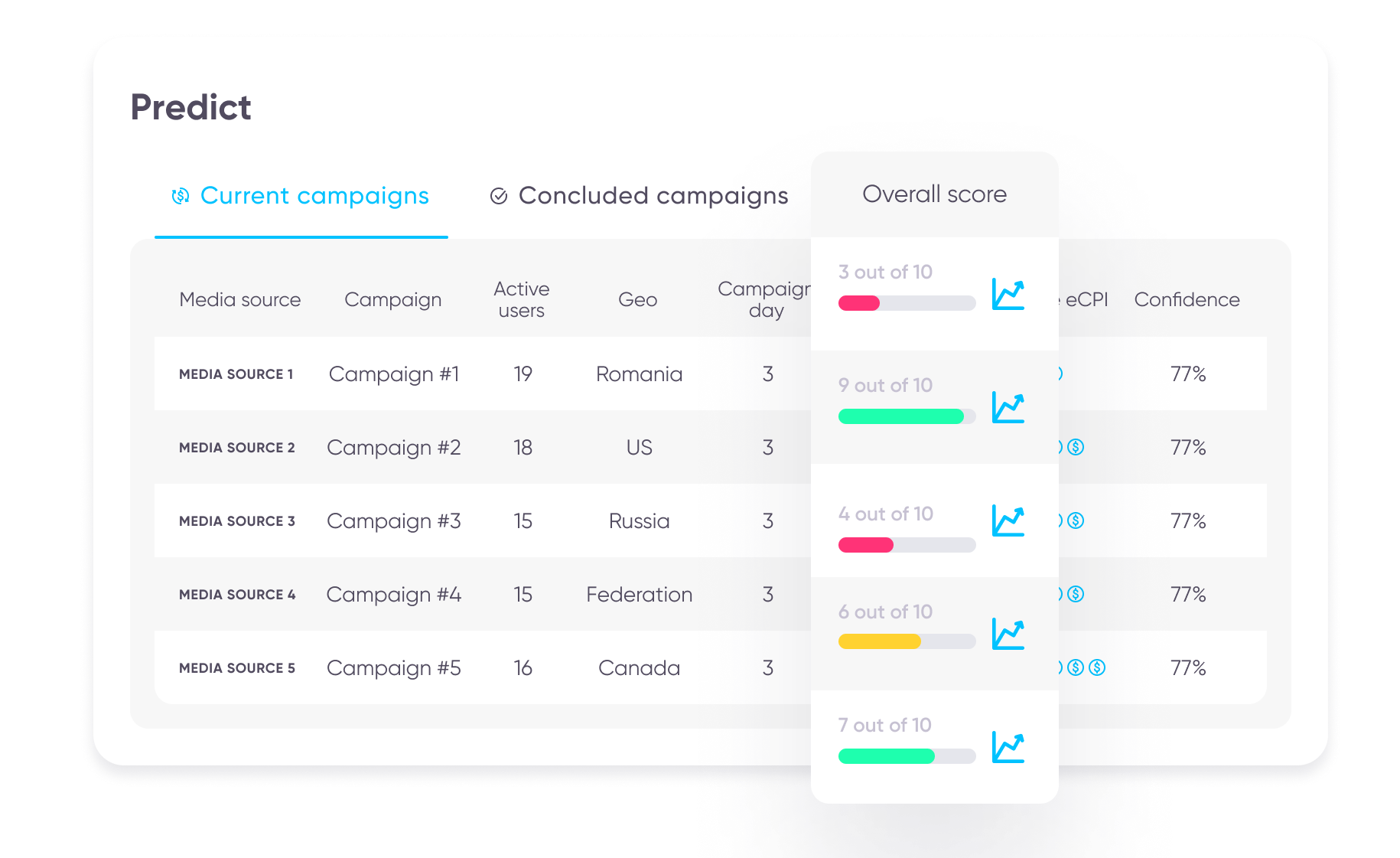
Predictive marketing explained – why it matters

The role of a user acquisition (UA) manager has drastically evolved over the years with increasingly challenging tasks.
UA managers often struggle to find effective ways to optimize their campaigns and obtain high-quality users. Many BI solutions and third-party technologies are typically used to try and determine the cost to acquire a user, counter it with user LTV, and handle the overall uncertainty of user ROI.
However, more often than not, a UA manager’s gut-feeling about a campaign’s potential is the real decision-maker, as sufficient decision-making data is often missing or lacking.
User acquisition optimization – how does it actually work?
Naturally, mobile app developers want to attract more users to their app. This can be achieved either organically or via multiple advertising channels and activities.
Acquiring paid users is mostly done by using ad networks (Tapjoy, Unity, ironSource, etc.) or large publishing platforms (Facebook, Google, Twitter, etc.). Advertising campaigns consist of different user cohorts, which can be segmented by various demographics, geo-locations, publisher apps, in-app behavior, and more.
For example, an advertiser could try to reach users in the UK on Tinder (when working with traditional ad networks) or a category of women aged 20-34 who like gaming on Facebook.
For each one of these targeted cohorts, the UA manager defines campaign attributes that include budget, daily impression cap, and most importantly, the bid price (the amount of money the UA manager is willing to pay per user, aka PPU).
Once a user installs and engages with an app, the UA manager monitors and measures their user journey.
During the user’s lifespan, they will generate value through different types of KPIs:
- Monetization – revenue from in-app purchases, ad views, subscriptions, offer walls, etc.
- Engagement – user activity that represents app involvement and contribution to the app economy
- Retention – a user’s app usage, frequency, and stickiness
The UA manager’s role is to ensure that the value generated from each user surpasses the cost to acquire them. The main challenge is to accurately measure the user’s lifetime events, a process which can take anywhere from three weeks to twelve months, depending on the app.

In a perfect world, determining a user’s cost would only be confirmed once their LTV is clear.
Unfortunately, advertisers are required to pay upfront, causing significant uncertainty to a campaign’s management.
The LTV chase
Advertisers invest substantial resources in BI systems, dedicated teams, and utilize data science to try and identify different points along the user journey that only hint at user LTV. The more advanced the BI setup, the more likely the UA manager is to find closer proxy points.
Such analysis requires roughly 7-14 days to accumulate sufficient data to generate an initial user LTV insight. To make these insights reliable and “clean”, no changes can be made to the campaign during this period.
It’s only when a reliable insight is received that a UA manager can optimize each campaign by changing bids, creative, or targeting.
The painful trade-off for this learning period is that insight accuracy increases the longer an advertiser waits. However, the longer they wait for better accuracy, the greater the loss of money is for unsuccessful campaigns; thus money is lost because of unsuccessful campaigns or failure to capitalize on potentially successful campaigns.
What is predictive analytics?
For some app developers the linear model for LTV estimation may be sufficient; however, for most app developers a more sophisticated prediction method is needed and could be a game-changer.
Having a method of measuring a user’s app activity during the initial day or two, and then accurately correlate it to long-term LTV is the holy grail.
The main challenge is that such a correlation is not intuitive. It will require numerous actions and patterns measured over the first couple of hours and days of a user’s journey within the app, and a host of complex tools for analyzing and driving predictions. This field of research is called predictive analytics.
Outside of the marketing industry, the science of predictive analytics is used to help analyze historical data and patterns to predict anything from stock market shifts to potential health hazards.
Injecting this science into the world of marketing seems intuitive, but it’s not easy to carry out. Even today, with the vast commoditization of various data platforms, performing predictive analytics for user LTV requires significant resources and access to a wide variety and scale of data sources.
The type of method needed includes deep learning, a smart label definition, and dynamic feature engineering. The server costs required in order to run these types of models can be exorbitant.
While many UA managers might be aware of the benefits of using predictive analytics, this privilege is limited to a lucky few. The vast majority of app marketers do not have the resources to pull such an elaborate operation, leaving them to rely on limited calculation models at best or their gut feeling at worse.
Solving the predictive marketing equation
In order to build and train complex deep learning predictive models that can provide these desired LTV predictions, access to large user behavior databases is needed.
Even if the predictive model only applies each app’s siloed data to generate local predictions, the model’s training and optimization must rely on data from hundreds if not thousands of apps to achieve maximum accuracy.
Very few companies are privileged enough to enjoy a birds-eye-view of user acquisition properties, including monetization and cost channels, as well as access to all app campaigns across all advertising sources and channels.

For example, if a certain advertiser is working with five different ad networks, each network may have access to significant amounts of data, but won’t have exclusive access to all UA campaigns. Their data is thus limited to their own campaigns and media. These media sources, by nature, cannot be unbiased.
Why is this the necessary next step?
Attribution measurement is going through some major changes.
As we head into a new, privacy-centric reality we must adopt a new measurement standard – one that requires shorter measurement time frames and applies anonymous user potential scores for decision making.
Predictive marketing does just that!
Leveraging its unique position and massive attribution database perfectly positions AppsFlyer to achieve reliable and accurate insights. We utilize a broad ecosystem view, extensive human and computing resources, and an unbiased industry position to provide accurate predictive insights in minimal time.




